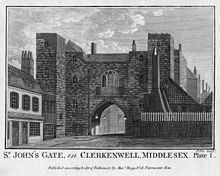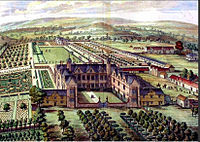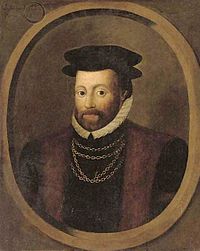- Maurice Denys
-
Sir Maurice Denys (1516–1563) was an English lawyer in London, a property speculator during the Dissolution of the Monasteries, during which period he served as a "powerful figure at the Court of Augmentations",[1] a Member of Parliament for Malmesbury in Wiltshire, Treasurer of Calais and the builder of Siston Court in Gloucestershire.
Background
 Sir Nicholas Poyntz(d.1557) of Iron Acton, Glos., husband of Jane Berkeley, 1st cousin of Maurice Denys. Drawing by Hans Holbein the Younger, Royal Collection, RL 12234
Sir Nicholas Poyntz(d.1557) of Iron Acton, Glos., husband of Jane Berkeley, 1st cousin of Maurice Denys. Drawing by Hans Holbein the Younger, Royal Collection, RL 12234
Denys was the second son of Sir William Denys (died 1533) of Dyrham, Gloucestershire, by his second wife Anne Berkeley, daughter of Sir Gilbert Denys(d.1422) of Waterton, Glamorgan, who had moved to Gloucestershire following his first marriage in 1379 to Margaret Corbet, heiress of Siston.
Career as Lawyer
Denys entered the Inner Temple in London, and was appointed marshal (1542-4, 1546), steward (1545-6) and bencher (1547).
Receiver of Order of St. John
 St John's Gate, Clerkenwell in 1786, the only remaining part of the once extensive headquarters of the Order
St John's Gate, Clerkenwell in 1786, the only remaining part of the once extensive headquarters of the Order
In 1537, he was granted by King Henry VIII the Receivership of the former Order of Saint John. This may have been due to his eldest brother, Sir Walter, having married Margaret Weston, daughter of Sir Richard Weston(d.1541) of Sutton Place, Surrey, elder brother of Sir William Weston, the last prior of the Order before its dissolution. Denys took up residence at Clerkenwell, which had been the Order's headquarters and also at St John's Jerusalem, its former Commandery at Sutton-at-Hone in Kent. He continued as Receiver of the Order until 1544, and after that was Receiver jointly with Thomas Poley.[3]
Acquires brother's patrimony
Denys later bought the ancestral Denys manor of Siston from his elder brother, Sir Walter, who had inherited it, perhaps in the year 1542 when his brother needed to obtain a Royal licence to sell him Kingston Russell,[4] and went on to build a new country house there, known as Siston Court. The evidence for Sir Maurice being the builder of Siston Court comes from a letter summarised in the Cecil Papers[5] dated 1607 to Robert Cecil, 1st Earl of Salisbury from an agent offering him the property for sale:
"Offers for sale the manor of Siston Glos., 6 miles (9.7 km) from Bath & from Bristol, heretofore the land of Sir Morris Dennis, present owner Mr Weeks. There is a new house of stone which cost £3,000 built by Dennis; a park which will keep 1,000 fallow deer & rich mines of coal which yield almost as great revenue as the land"
Siston was built at about the same time as two of his relatives were also building nearby: Sir Nicholas Poyntz(d.1557), husband of his first cousin Jane Berkeley, at Newark Park near Wotton-Under-Edge and Sir Richard Berkeley(d.1604) his nephew at Stoke Park, Stoke Gifford. He borrowed heavily to buy not just Siston, but also Barton Regis, a former Royal manor in Kingswood Forest.[6] a large part of the Forest itself, and Abson and Pucklechurch from William Herbert, 1st Earl of Pembroke, who had obtained the last at the Dissolution, as well as other manors in Gloucestershire and other counties.[3]
Marriage
On 3 February 1545 Denys married Elizabeth(d.1572), the widow of the Mercer Nicholas Statham(d.1538). Her family name is not known. Statham had been admitted to the Mercers' Company in 1512 as an apprentice of Robert Imber. He served as one of the 4 wardens of the company in 1532, as Second House Warden. In 1535 he is recorded as having shipped, together with his son-in-law Vincent Randall, 349 Kerseys to Sinxen Mart as part of a group of 114 cloth shippers.[7] His will dated 1538 was "sparse" and "suggests a sombre support of the new ways" according to Anne Sutton.[8] He did not, as had been previously common of Catholics, mention the Virgin Mary or his parish. His main bequest was of 500 marks to be lent to "the moost honnest, towarde and thryving yonge men" [9] of the Mercers' Company. The interest therefrom, stipulated at 25 marks p/a, was directed to the use of St Bartholomew's Hospital "where the king's grace will thereto appoint and give licence". This was a common way of providing an indirect religious bequest at the politically sensitive time of the Reformation after the abolition of chantries. If his main bequest should have been disapproved he provided that instead a hundred poor people of London should be given black gowns. He left several small bequests. Elizabeth was his residuary legatee and sole executrix. The execution of Statham's bequest however seems to have been blocked by Elizabeth's new husband Denys, and the money was not released until 1550, after Denys himself had been admitted gratis to the Mercers' Company [10] At Brook Place, Sutton-at-Hone, Denys had previously built a great house for Statham.[11] The name "Brook Place" may have been its name after Statham's time, in recognition of the locally important Brooke family. This house was later renamed "Sutton Place", partially demolished and covered in white stucco. On his marriage to Elizabeth Statham, Denys gained possession of Brook Place [3] although following Denys's death it was inherited by Elizabeth's daughter, from her previous marriage,[12] who had married the Mercer Vincent Randall, who became Master of the Mercers' Company in 1574. Elizabeth is known to have been an active supporter of the new Protestant religion, of the unorthodox Evangelist variety.[13] She had entertained at her house on the corner of Milk Street (rented from the Mercers)[14] Hugh Latimer(martyred 1555), Robert Barnes, Thomas Garret and William Jerome, (martyred together in 1540) and other evangelicals, and in 1540 had been indicted under the first enquiry under the Six Articles to abolish "diversity in opinions". Bishop Bonner chaired the commission, which included at least 5 mercers: John Alen, Ralph Warren, Richard and John Gresham and Michael Dormer and Guy Crafford, the lawyer and grandson-in-law of Lady Joan Bradbury. Elizabeth was then assessed as worth over £500. In her will dated 1572 [15] she left several charitable bequests, to be distributed by the Dean of St Paul's, designed to encourage the new religion by funding poor scholars at the universities. She also left a bequest to Christ's Hospital. These bequests were opposed by her son-in-law Randall, but were upheld by the probate court.[16]
Legal action over Sankey
On 8 May 1544, shortly before her marriage to Denys Elizabeth had acquired lands in Great Sankey, Warrington, Cheshire, from Sir Thomas Boteler, who very soon thereafter "made a forcible entry upon and a tortious possession of a messuage and lands in Sankey" on account of which he was sued, before the end of 1544, in the joint names of Elizabeth and Maurice Denys. The couple then sold their Sankey lands to Denys's brother-in-law Walter Bucler, who in turn on 1 January 1547 exchanged them with the king for other lands in Sankey.[17]
Acquires Wye College
In 1546 Denys acquired Wye College, Kent, from Walter Bucler, who had been granted it by the crown following the Dissolution. Bucler was secretary to Queen Katherine Parr and second husband of Katherine Denys, Maurice's sister, whose first husband Edmund Tame II of Fairford, Glos. had died in 1544. Bucler's licence to alienate, dated at Westminster 25 December 1546 is recorded in the Patent Rolls:[18]
"Walter Bucler to Maurice Denys and Elizabeth his wife. Mansion, etc., of the late College of Wye, Kent, manors of Perycourte and Surrenden, rectory of Promhill, pensions of 33s. 4d. out of Westwell rectory, 10s. out of Hothefield rectory and 8s. out of Estwell rectory, and all lands in Wye, Wydtheston, Nacolt, Henxsell, Goodmesham, Crondale, Charter Magna, Bethersden, Postlyng, Westbury and Promhill, Kent, which belonged to Wye College.
Knighted
On 22 February 1547, two days after the coronation of Edward VI, Denys was knighted, and in the same year he became a bencher of the Inner Temple and a Justice of the Peace for Gloucestershire and Kent, as well as being elected to the House of Commons of England as Member of Parliament for Malmesbury in Wiltshire. Also in 1547, he sold some of his land in Clerkenwell to Sir Edward North, who had acquired in 1545 following the Dissolution the nearby London Charterhouse and made it his London mansion. In May 1548 he sold the manor of Surrenden to Sir Anthony Aucher(d.1558),[3] of Otterden in Kent, a commissioner for that county, whose burial place in Bishopsbourne Church in Kent records as follows:
"Sr. Anthony AUCHER, Knt. Mareschall of Callice; Governr. of Guisnes; Master of the Jewel House, in Times of HENRY YE EIGHT. EDWARD YE SIXT, and QUEEN MARY. Slayn at ye Loss of Callice"
Acquires Pardon Chapel
The Feet of Fines for Middlesex contain the following entry for 1547, the first year of the reign of Edward VI:[19]
"Sir Edward North, knight, Chancellor of the Court of Augmentations, and Alice his wife and Sir Maurice Denys and Elizabeth his wife. Premises and a chapel called Pardon Chapel, in the parish of Clerkenwell. Trinity. Anno 1".
This comprised a chapel and presumably also the graveyard attached to St James's Church, Clerkenwell, then part of the London Charterhouse, known as the "Pardon Churchyard" and used to bury suicides and those executed as felons. It stood between Great Sutton St and Clerkenwell Rd.[20]
Treasurer of Calais
In December 1548, under the Protector Somerset, Denys was appointed Treasurer of Calais, a position which required him to reside in Calais and which proved an unhappy task, thanks chiefly to the shortage of funds. His uncle Governor of Calais, but died there in 1523 before he had taken up the post. In April 1550, the Privy Council rebuked Denys for pressing Lord Clinton (as he then was) not to release Boulogne to the French until they had paid a treaty obligation under the Peace of Boulogne. In February 1551, after power had passed to Northumberland, Denys was granted a pension of £150 a year for life.
Committed to Fleet prison
In June of 1552, commissioners were sent to audit Denys's accounts and in July they were ordered to investigate what had been done with money he said he had not received. On 20 November he was called back to England and on the 26th was imprisoned in the Fleet. He was summoned to present himself to the Council on 29 January 1553, with commissioners to examine his case in April. Between May and August he appears to have been back in post as Treasurer of Calais, as he was receiving new instructions, but on 12 September was again committed to the Fleet, in due course to be released again.[3]
Liquidates landholdings
By now, Denys's wide-reaching purchases were proving too ambitious, and debts weighed on him heavily. He sold several estates, probably to defray debts incurred in his post at Calais.[3] In 1553, he sold Wye College in Kent to Sir William Damsell.[21] Siston was also sold before his death to satisfy his creditors.[3]
Greets Cardinal Pole
On 18 November 1554, under Mary I, who had reintroduced catholicism, Denys was ordered by the Privy Council to go to Rochester to join George Brooke, 9th Baron Cobham in welcoming the catholic Cardinal Pole back from his exile. Pole rapidly became one of the main forces behind the burning of many English protestant martyrs. Denys had no other government work under Mary, which may have been connected not only with his debts but also with his religious sympathies.
Disposes of Burton manor
In August 1556 he failed to honour two payments to the Crown, one of 1,000 marks and one of £579, so was forced to pledge his manor of Burton in Gloucestershire, and in February 1557 he sold other estates around Bristol.[3]
Pardoned
Denys was pardoned and rehabilitated by Elizabeth I in January 1559 and began to resume his career.
Death
In November 1562 he was at Portsmouth to pay soldiers and may have remained there. He died at Portsmouth on 25 August 1563, probably of the plague which had broken out there. The "Cecil Papers" at Hatfield House contain the following entry, which followed a similar one three days before:[22]
"Sir Adrian Poynings to the Queen. Concerning the state of payments to the troops from Newhaven (i.e. Le Havre) at the death of Sir Maurice Denis (sic) Treasurer. Wherwell 28/8/1563.
Will
He had made a complicated Will on 29 October 1562, which was proved on 29 January 1564, after the Marquess of Winchester had ordered the Prerogative court of Canterbury to take over the administration of Denys's estates "for the ease of my Lady Denys, who minds not to take any charge of her late husband's testaments because his debt to the Queen's Highness is not known".[3]
Dame Elizabeth Denys's Jewels
A deed dated 2nd Feb. 1563 is preserved amongst the charters of Margam Abbey in Glamorgan recording the return of Elisabeth's jewels by Denys's nephew Thomas Carne of Ewenny Priory, son of his sister Anne and Sir Edward Carne:[23]
"A Deed whereby Dame Elizabeth Dennys, wife of Sir Mauryce Dennys of St. John's Street, in county Middlesex, knight, acknowledges the receipt from Thomas Carne of Wenny county Glamorgan, Esq., of a cheyne of gold with a button, a jewyll with an unicornes horne, thre dyamondes, and one obligacian of £40 for a ring which must be delyvered the last day of this instant Februarye and if the said Thomas shall pay £30 on 31st May next then a recognisauce dated 21st Dec. 1561 to be void. Signed, sealed, and attested by Thomas Marshall junior son of Thomas Marshall, notary".
Sources
- Bindoff, Stanley T.(ed.), History of Parliament, House of Commons, 1509–1558, London, 1982, vol.2, pp. 31–33, "Denys, Sir Maurice", biog. by T.F.T. Baker
- Maclean, Sir John (ed.), Visitation of the County of Gloucester Taken in the Year 1623 by Henry Chitty & John Phillipot, London, 1885, pp. 49–52, Dennis
References
- ^ Sutton, Anne, op. cit. p.462
- ^ Sir William Denys's 1st wife, whom he married in about 1482 & who was short-lived, was Edith Twynyho, da. of John Twynyho(d.1485), a wealthy cloth merchant of Cirencester, MP for Bristol 1472-5, 1484, and sister-in-law to John Tame(d.1500), of Fairford, Glos., business partner of John Twynyho. The marriage settlement is contained in a charter dated 21 Ed IV (1482)
- ^ a b c d e f g h i Stanley T. Bindoff, 'Denys, Sir Maurice', in The House of Commons: 1509-1558, vol. 2, pp. pp. 31–33 (& see also pp. 34-37)
- ^ Letters and Papers of Henry VIII, vol. xvii, p. 443
- ^ Cecil Papers. vol 19, p.433. (124.72)
- ^ Cecil Papers, vol. 24., 6/5/1609
- ^ Sutton, Anne, p.412, note 9
- ^ Sutton, Anne, op. cit., p.392
- ^ Sutton, Anne, op.cit. pp.461-2, note 111
- ^ Sutton, Anne F. The Mercery of London: Trade, Goods and People, 1130-1578, Aldershot, 2005, p.548, short biog. of Nicholas Statham; p.392, his will; p.462, Denys admitted to Mercers
- ^ Ireland, William Henry. England's Topographer: or a New & Complete History of the County of Kent, 1830
- ^ Ireland, W.H., A New & Complete History of the Co. of Kent, London, 1830. Vol.4, Sutton, pp.368-373
- ^ Sutton, Anne F. The Mercery of London: Trade, Goods and People, 1130-1578, Aldershot, 2005, p.548, short biog. of Nicholas Statham
- ^ The house on milk Street had been let to Nicholas Statham. In 1550, when the tenant was Hugh Edwards, the Mercers' Company sold the house to Sir John Gresham. Sutton, Anne, p.526
- ^ PROB 11/27, folio 174, will of Elizabeth Denys
- ^ Sutton, Anne, op.cit. p.548; p.392, note 75 re. bequest; PROB 11/56 folios 25-26 & 235v-36 for upholding of her wishes
- ^ Beaumont, William. Annals of the Lords of Warrington, 1872, Part 2
- ^ From Patent Rolls, 38 Henry VIII (25/12/1546, Westminster, part 12, membrane 45) Letters and Papers, Foreign and Domestic, Henry VIII, Volume 21 Part 2: September 1546-January 1547 (1910), pp. 203-248. URL: http://www.british-history.ac.uk/report.aspx?compid=80883 Date accessed: 15 May 2011.
- ^ London and Middlesex Fines: Edward VI, A Calendar to the Feet of Fines for London & Middlesex: volume 2: Henry VII - 12 Elizabeth (1893), pp. 68-86
- ^ John Strype's "Survey of London"
- ^ Bindoff, op. cit., vol. 4, p. 9
- ^ Cecil Papers, vol 1. no.924
- ^ Clark, George T. Cartae et Alia Munimenta quae ad Dominia de Glamorgan Pertinent, vol. 5, Charter no 1436, pp.2059-60
Categories:- Denys family
- People of the Tudor period
- English knights
- 1516 births
- 1563 deaths
- 16th-century English people
- Members of the pre-1707 Parliament of England
- People from Gloucestershire
- Figures of the Dissolution of the Monasteries
- Treasurer of Calais
- Prisoners in Fleet Prison
Wikimedia Foundation. 2010.





